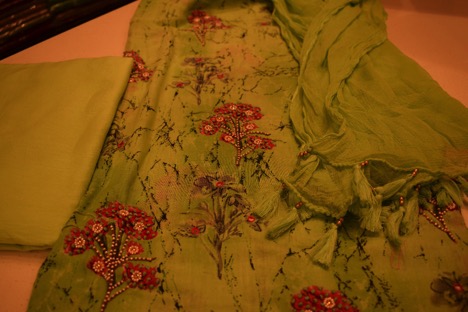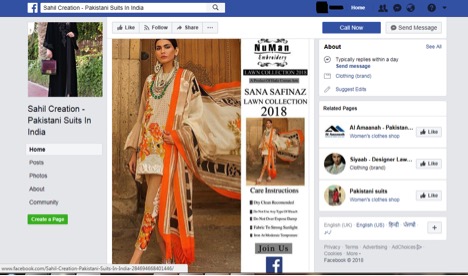Among the many things that tie the women of India and Pakistan together, their love for Pakistani suits is near the top of the list.
India is no stranger to producing high-quality ethnic Salwaar suits, but the ones that Pakistan offers are simply too outstanding to ignore. “Pakistani suits are fresh and stylish and putting them on makes you stand out,” says Asmita, a 27-year-old PhD scholar and a fashion enthusiast.
The fascination for Pakistani suits started a decade ago – further propelled by Pakistani serials being televised in India. “Through television, the commonalities between the two countries were brought to the fore. Pakistani wears are different from the ones here, hence the craze,” says Nayanika Thakur, Fashion coordinator at the National Institute of Fashion Technology (NIFT), New Delhi.

Soft to touch and light in feel Lawn-based suit
Credit: Sania Ashraf and Yash Shukla
So, what is it that makes the Pakistani suits so special? The only answer we get is ‘Lawn’, a cotton exclusive to Pakistan. The fabric is feather-light, soft and regal-looking, adding to most of the charm of the suits. “Lawn is God-given to Pakistan. Some lands produce exceptional wheat, some exceptional rice and Pakistan produces Lawn,” says Shabana.
Indian manufacturers have tried to replicate Lawn but to no avail. “Replicas are manufactured mostly in Surat, Gujarat but the difference in quality is fairly evident,” says Zeeshan, owner of Ali Colors. Original Lawn products are priced between Rs 800-18,00, while the replicas are around Rs 500-2500.
Gul Ahmed, Sana Safinaz, Maria B and Khaadi are some of the more expensive brands that have managed to find a steady customer base in India. Apart from Lawn, India also imports other fabrics like gorgettes, chiffons and denims from Pakistan which find many takers in the months of summer, while in winters these are replaced by chambray, silk and velvets.

Pakistani suits with their respective catalogues
Credit:Sania Ashraf and Yash Shukla
The craft of suit-making is shared by both India and Pakistan owing to their cultural similarities. Yet Pakistanis experiment more when it comes to patterns and designs. “The ankle-length Kameez, which is now donned by Indian women, was a trend that started there around 6-7 years back. Now in Pakistan, those long ones have been replaced by knee length Kameez with narrower pants. It will take some years for that trend to seep into India,” says Thakur.

Women looking at catalogues
Credit: Sania Ashraf and Yash Shukla
The imported suits are largely unstitched and accompanied with separate embellishments, allowing for easy customisations.
Despite their charm, Pakistani suits don’t have many takers among younger shoppers. “They do not prefer suits and probably buy them because their mothers want them to,” says Thakur.
The market is also foraying into the virtual world, with Whatsapp and Facebook groups becoming ‘stores’. Giants like Flipkart and Amazon also carry these suits, often at a bargain. However, this usually works better for seasoned suit buyers who can tell the difference between the many fakes sold online.

A Facebook page where buying and selling of Pakistani suits take place Credit: Sania Ashraf and Yash Shukla
Old Delhi’s Chandni Chowk and Meena Baazar markets are shopping hubs where wholesalers get their imports and distribute them pan-India. Largely confined to women’s wear, traders also seasonally import ethnic Kurtas for men, especially on festivals like Id and Diwali. However, this has not always been easy to sustain as high import duties imposed on Pakistani wears mean higher prices for the customer. “The wholesale price here in India is close to the retail price in Pakistan,” says Danish.
Upendra Das from the Indian Institute of Foreign Trade says, “Lawn is not something which can be produced in Indian industries. Hence, levying more than 40% tariff has nothing to do with protecting domestic producers.” India-Pakistan trade relations should aim to become as strong as India-Bangladesh trade he says.
Laughing in disbelief at the possibility of directly importing from Pakistan, Zeeshan added, “It’s too risky for us to directly trade with Pakistan taking into consideration the frosty relations between the countries. Even now trade gets disrupted at the drop of a hat.”

Fine detailed work in the suits
Credit: Sania Ashraf and Yash Shukla
Mohammad Osama who has been selling Pakistani suits and Chadars (scarves) at Chitli-Qabar market in Old Delhi for more than 20 years added, “We get our supply from Meena Baazar traders, who have a ‘setting’ on the border. Not always, but yes, during firing and disturbances at the border, these big traders arbitrarily increase the prices.”
To the proposition that big traders feed on the inability of small shop-keepers to directly import from Pakistan, Athar Khan said, “Unlike small traders, we import in bulk and have to pay in advance to get our consignment. Small traders cannot pay in advance and get things from us on credit. Often we inflate prices at our walk-in showrooms in order to help small sellers. If a customer gets a suit at Rs 1000 from our showrooms, then why would she go to a small shop? So we inflate our prices to make customers buy from local sellers. This not only helps small traders but also helps us because a major part of our business is wholesale. Walk-in showrooms are only there to establish our brand.”

A mannequin at Ibaas, a famous Pakistani Suit store in Chandni Chowk
Credit: Sania Ashraf and Yash Shukla
In order to spare themselves from political uncertainties, big traders have devised a third country route which is also known as neutral capital route amongst the traders. “Instead of directly importing from across the border, we import from Dubai,” says Khan. “Apart from politics-fraught Indo-Pak relations, bureaucracy and complicated regulations have only made matter worse,” said Das.
Seeing the possibility of better relations in the form of cross-border trade, Das added, “Gone are the days when trade would follow the Flag (diplomacy). In the modern age it is the other way round the Flag (diplomacy) follows trade. Once trade relations are established, the people of India and Pakistan would never let politics and their governments put their livelihood at stake. Trade is the first casualty of war and people won’t let that happen.”
Sania Ashraf and Yash Shukla are pursuing their post-graduation in Convergent Journalism, AJK MCRC, Jamia Millia Islamia.

